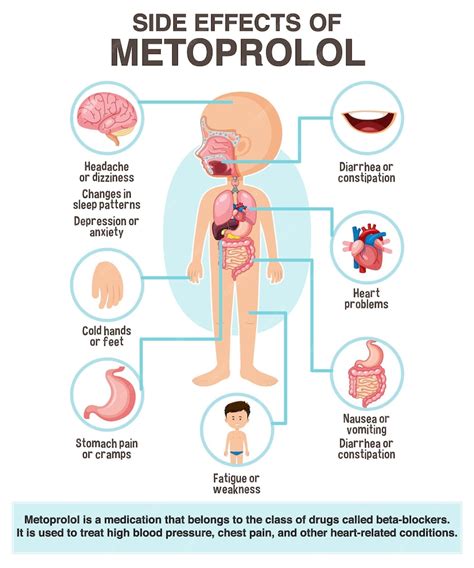Intro
Discover 5 common Metoprolol side effects, including fatigue, dizziness, and shortness of breath, and learn how to manage beta blocker symptoms, interactions, and warnings for a safer treatment experience.
Metoprolol is a widely prescribed medication for managing high blood pressure, chest pain, and certain heart-related conditions. It belongs to a class of drugs known as beta-blockers, which work by slowing the heart rate and reducing the force of the heart's contractions. This helps to lower blood pressure and improve blood flow to the heart. While metoprolol is effective in treating various cardiovascular conditions, it can cause several side effects. Understanding these side effects is crucial for patients who are taking or considering taking metoprolol.
The importance of being aware of metoprolol side effects cannot be overstated. Side effects can range from mild and temporary to severe and potentially life-threatening. Patients who are informed about the possible side effects of metoprolol are better equipped to manage their condition, recognize when something is amiss, and communicate effectively with their healthcare providers. Moreover, knowledge about side effects can help in making informed decisions about treatment options and lifestyle adjustments that may mitigate these effects.
Metoprolol, like all medications, affects people differently. What may be a minor side effect for one person could be a significant issue for another. Factors such as age, overall health, dosage, and individual tolerance play a role in how metoprolol is tolerated. It's also worth noting that while side effects are a consideration, for many people, the benefits of taking metoprolol outweigh the risks. By understanding the potential side effects and discussing them with a healthcare provider, patients can navigate their treatment plan with confidence.
Common Side Effects of Metoprolol

Less Common but Significant Side Effects
Less common but potentially more serious side effects of metoprolol include shortness of breath, swelling of the feet or hands, and cold hands and feet. These could be indicative of more serious heart or circulatory problems and should be reported to a healthcare provider. Metoprolol can also affect the respiratory system, leading to bronchospasm in people with asthma or chronic obstructive pulmonary disease (COPD). Furthermore, there have been reports of metoprolol causing depression, although this is relatively rare.Metoprolol and Its Impact on Daily Life

Managing Side Effects Through Lifestyle Changes
Lifestyle changes can play a significant role in managing metoprolol side effects. Regular exercise, a balanced diet, and adequate sleep can help mitigate some of the common side effects. For example, staying hydrated can help reduce the risk of dizziness and lightheadedness. Quitting smoking and limiting alcohol consumption can also improve overall health and reduce the risk of cardiovascular disease. Furthermore, stress management techniques such as meditation or yoga can help with sleep disturbances and emotional well-being.Long-Term Use of Metoprolol

Monitoring and Adjustments
Regular monitoring by a healthcare provider is crucial for patients on long-term metoprolol therapy. This includes checking blood pressure, heart rate, and performing occasional blood tests to monitor for any adverse effects on the liver or kidneys. Based on the results of these tests and the patient's overall health, the dosage of metoprolol may need to be adjusted. In some cases, switching to a different beta-blocker or adding another medication may be necessary to achieve the best outcome.Special Considerations for Metoprolol Use

Interactions with Other Medications
Metoprolol can interact with a variety of other medications, including other heart medicines, certain antidepressants, and over-the-counter cough and cold medicines. These interactions can increase the risk of side effects or reduce the effectiveness of metoprolol. Patients should inform their healthcare provider about all medications, supplements, and vitamins they are taking to avoid potential interactions.Conclusion and Future Directions

A Call to Action
As with any medication, the key to successful treatment with metoprolol is a combination of the right dosage, lifestyle adjustments, and regular monitoring. Patients should be proactive in discussing their treatment plan with their healthcare provider, including any concerns about side effects. By taking an active role in their healthcare, individuals can better manage their condition and improve their quality of life.What are the most common side effects of metoprolol?
+The most common side effects include dizziness, lightheadedness, fatigue, nausea, vomiting, and diarrhea. These are often related to the drug's effect on blood pressure and heart rate.
Can metoprolol affect my ability to exercise?
+Yes, metoprolol can affect your ability to exercise by reducing your heart rate and lowering your blood pressure. It's essential to discuss your exercise plans with your healthcare provider to find a safe and appropriate level of physical activity.
How long does it take for metoprolol to start working?
+Metoprolol can start to lower your blood pressure within a few hours of taking your first dose, but it may take a few weeks to reach its full effect. It's crucial to take the medication as directed and attend follow-up appointments with your healthcare provider.
